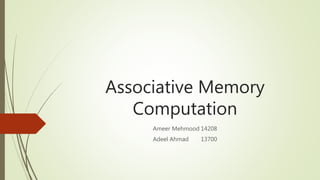
Associative Memory Computation: Fast Parallel Searching
- 1. Associative Memory Computation Ameer Mehmood 14208 Adeel Ahmad 13700
- 2. Introduction To search particular data in memory, data is read from certain address and compared if the match is not found content of the next address is accessed and compared. This goes on until required data is found. The number of access depend on the location of data and efficiency of searching algorithm. This searching time can be reduced if data is searched on the basis of content.
- 3. Introduction A memory unit accessed by content is called associative memory or content addressable memory(CAM) or associative storage or associative array. This type of memory is accessed simultaneously and in parallel on the basis of data content. Memory is capable of finding empty unused location to store the word.
- 5. Associative Memory Organization Associative Memory is organized in such a way. Argument register(A): It contains the word to be searched. It has n bits(one for each bit of the word). Key Register(K):This specifies which part of the argument word needs to be compared with words in memory. If all bits in register are 1, The entire word should be compared. Otherwise, only the bits having k- bit set to 1 will be compared.
- 6. Associative Memory Organization Associative memory array: It contains the words which are to be compared with the argument word. Match Register(M): It has m bits, one bit corresponding to each word in the memory array. After the matching process, the bits corresponding to matching words in match register are set to 1.
- 8. Associative Memory Organization Key register provide the mask for choosing the particular field in A register. The entire content of A register is compared if key register content all 1. Otherwise only bit that have 1 in key register are compared. If the compared data is matched corresponding bits in the match register are set.
- 9. Associative Memory Organization Reading is accomplished by sequential access in memory for those words whose bit are set.
- 10. Associative Memory Organization Let us include key register. If Kj=0 then there is no need to compare Aj and Fij. Only when Kj=1, comparison is needed. This achieved by ORing each term with Kj.
- 12. Associative Memory Organization Write operation: If the entire memory is loaded with new information at once prior to search operation then writing can be done by addressing each location in sequence. Tag register contain as many bits as there are words in memory. It contain 1 for active word and 0 for inactive word.
- 13. Associative Memory Organization If the word is to be inserted, tag register is scanned until 0 is found and word is written at that position and bit is change to 1. Read Operation: When a word is to be read from an associative memory, the contents of the word, or a part of the word is specified.
- 14. Associative Memory Organization If more than one word match with the content, all the matched words will have 1 in the corresponding bit position in match register. Matched words are then read in sequence by applying a read signal to each word line. In most application, the associative memory stores a table with no two identical items under a given key.
- 15. Associative memory Architecture It is a hardware search engines, a special type of computer memory used in certain very high searching applications. composed of conventional semiconductor memory (usually SRAM) with added comparison circuitry that enable a search operation to complete in a single clock cycle. SRAM is a type of semiconductor memory that uses bistable latching circuitry to store each bit.
- 16. Types of Associative memory There are two types of Associative memory, which both are used in different conditions. Auto-associative Auto-associative memory takes back(retrieves) a previously stored pattern that most closely resembles the current pattern.
- 17. Types of Associative memory Hetero-associative Hetero-associative memory, the retrieved pattern is in general, different from the input pattern not only in content but possibly also in type and format. Neutral networks are used to implement these associative memory models called NAM (Neutral associative memory).
- 18. Advantages of Associative memory This is suitable for parallel searches. It is also used where search time needs to be short Associative memory is often used to speed up databases, in neural networks and in the page tables used by the virtual memory of modern computers. CAM-design challenge is to reduce power consumption associated with the large amount of parallel active circuitry, without sacrificing speed or memory density
- 19. Disadvantages of Associative memory An associative memory is more expensive than a random access memory because each cell must have an extra storage capability as well as logic circuits for matching its content with an external argument. Usually associative memories are used in applications where the search time is very critical and must be very short.
